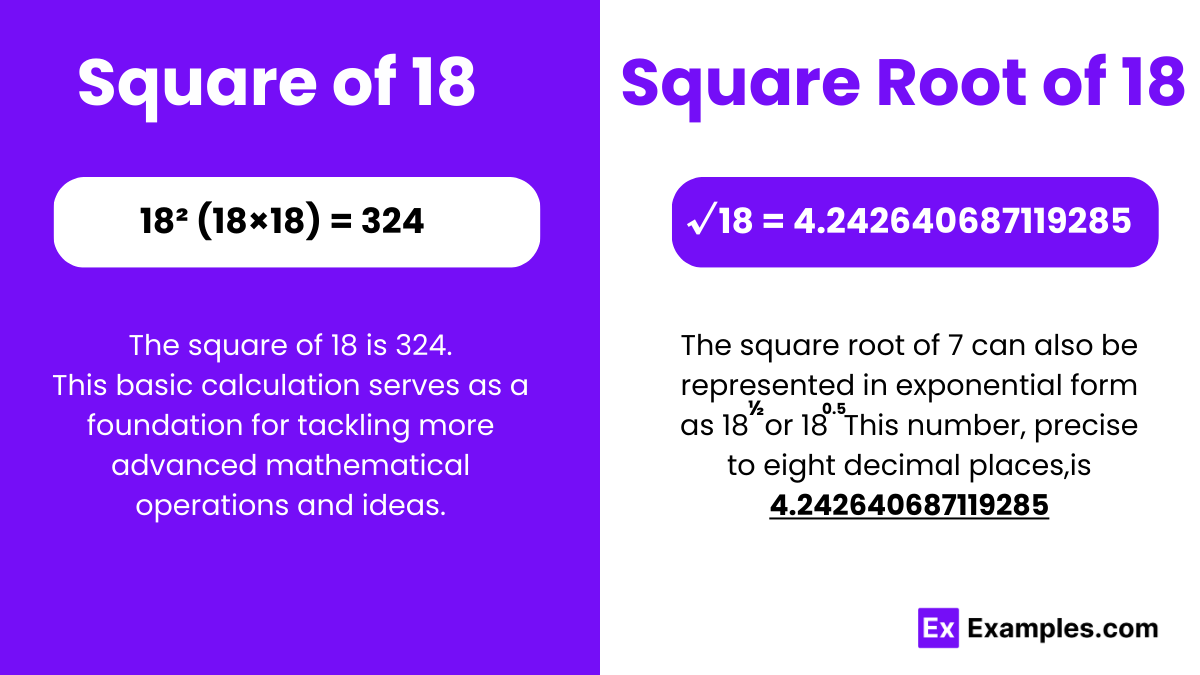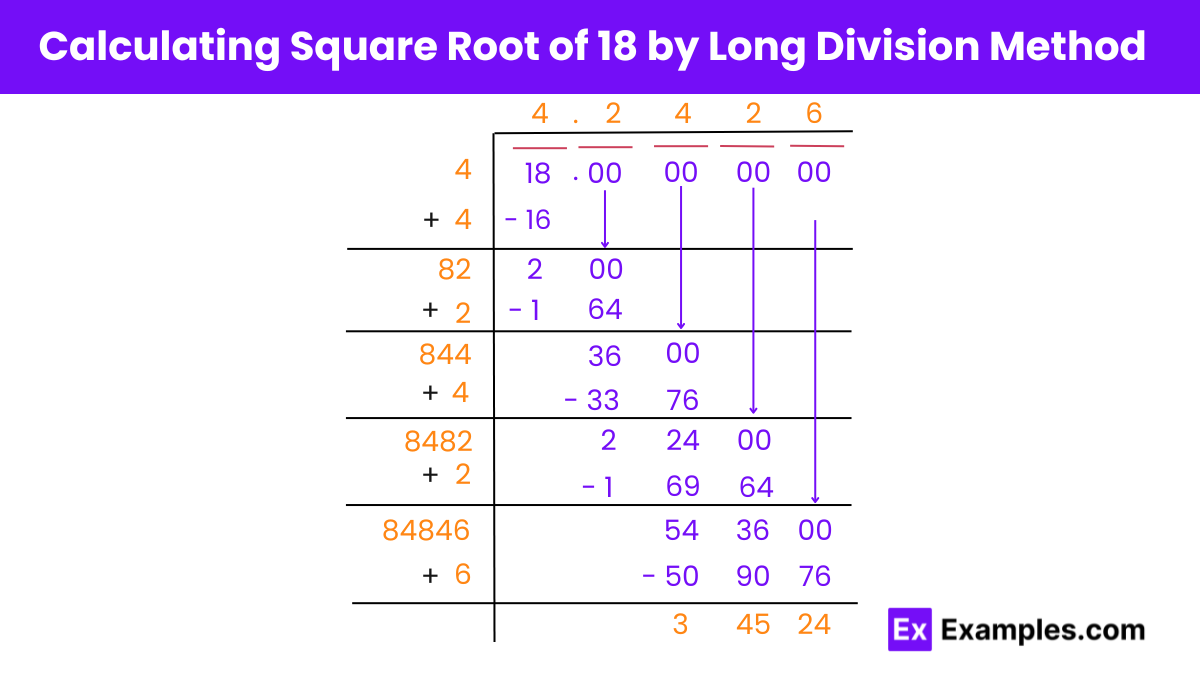What is the square of 18?
324
328
336
342

18² (18×18) = 324
The “square of 18” is the result when the number 18 is multiplied by itself.
In mathematical terms, it’s written as 18², which equals 324. To calculate the square of 18, you simply multiply 18 by 18. This multiplication yields the value 324, indicating that the area of a square with sides measuring 18 units each is 324 square units. So, to find the square of any number, including 18, you multiply the number by itself.
√18 = 4.242640687119285
or
√18=4.242 up to three places of decimal
The square root of 18, symbolized as √18, is a fundamental concept in mathematics. It represents the value that, when multiplied by itself, results in 18. In simpler terms, it’s the number which, when squared, equals 18. However, unlike whole numbers or fractions, the square root of 18 is an irrational number. This means its decimal representation goes on infinitely without repeating a pattern. When calculated, the approximate value of the square root of 18 is 4.242640687119285. Despite its seemingly random decimal expansion, the square root of 18 holds significance in various mathematical calculations, geometric problems, and real-world applications. Understanding this concept helps us comprehend the relationship between numbers, shapes, and quantities, contributing to problem-solving and analytical skills in fields such as engineering, physics, and finance.
Exponential Form: 18^½ or 18^0.5
Radical Form: √18
The square root of 18 is an irrational number.
To understand why, let’s delve into the definitions of rational and irrational numbers.
Rational numbers are those that can be expressed as a fraction of two integers, where the denominator is not zero. In other words, they can be written in the form a/b, where a and b are integers and b is not equal to zero.
Examples of rational numbers include 1/2, -3, and 5.
An irrational number cannot be expressed as a simple fraction of two integers. Their decimal representations are non-repeating and non-terminating.
Examples of irrational numbers include √2, π (pi), and √3.
Square Root of 18 as Irrational:
When we calculate the square root of 18, we find that it cannot be expressed as a fraction of two integers.
Its decimal expansion, approximately 4.242640687119285, goes on infinitely without repeating a pattern.
To understand why the square root of 18 is irrational, let’s simplify it:
√18 = √(9 × 2) = √9 × √2 = 3 × √2
Now, we know that √2 is famously irrational. It cannot be represented as a fraction of two integers, and its decimal form goes on forever without repeating. Therefore, 3 × √2 is also irrational because the product of a rational number (3) and an irrational number (√2) is always irrational.
In summary, the square root of 18 is irrational because it simplifies to an irrational number (√2) when multiplied by a rational number (3), and the result is always irrational.
When it comes to finding the square root of 18, there are several methods you can employ. Each method has its own advantages and may be more suitable depending on your familiarity with mathematical concepts and the level of precision required.
These methods offer clear and accessible approaches to finding the value of the square root of 18, catering to different preferences and levels of mathematical understanding.

Finding the square root of 18 using the long division method involves the following steps:
Step 1: Preparation
Write 18 as 18.00 00 00, grouping digits in pairs from the decimal point. For 18, it looks like “18”.
Step 2: Find the Largest Square
Identify the largest square smaller than or equal to 18, which is 16 (4²). Place 4 above the line as the first digit of the root.
Step 3: Subtract and Bring Down
Subtract 16 from 18 to get 2, then bring down the next pair of zeros to make it 200.
Step 4: Double and Find the Next Digit
Double the current result (4) to get 8. Now, find a digit (X) such that 48 multiplied by X is less than or equal to 200. Here, X is 4, because 484×4=192.
Step 5: Repeat with Precision
Subtract 192 from 200 to get 8, bring down the next zeros to get 800, then double the quotient (44) to get 88. Choose a digit (Y) so that 884 multiplied by Y is just under 800.
Step 6: Finish at Desired Accuracy
Continue the process until reaching the desired level of accuracy. For the square root of 18, this method gives us about 4.242 as we extend the division.
18 Is Not a Perfect Square Root
A perfect square root is a number that can be expressed as the product of an integer multiplied by itself. For instance, 4 (2 × 2) and 9 (3 × 3) are perfect square roots. To determine whether 18 is a perfect square root, we check if it can be written as the product of two identical integers.
However, upon examination, we find that there are no two integers x such that x × x equals 18. In other words, 18 cannot be expressed as the square of any integer.
Therefore, 18 is not a perfect square root. It does not have an integer square root. While it does have a square root (√18), it’s an irrational number and cannot be obtained by multiplying any whole number by itself.
In summary, 18 is not a perfect square root as it cannot be expressed as the product of two identical integers.
Is √ 18 a real number?
Yes, the square root of 18, denoted as √18, is a real number. A real number is any number that can be found on the number line, including both rational and irrational numbers. Since √18 exists on the number line and is not an imaginary number (which involve the square root of negative numbers), it is classified as a real number.
Is 18 an integer yes or no?
Yes, 18 is an integer. An integer is a whole number that can be positive, negative, or zero. Since 18 is a whole number and not a fraction or a decimal, it falls under the category of integers.
What is the square root of 18 between?
The square root of 18 lies between the integers 4 and 5. While the exact value of √18 is approximately 4.242640687, it’s important to note that it falls between the perfect squares of 4 (which is 16) and 5 (which is 25). Therefore, we can say that the square root of 18 is greater than 4 but less than 5.
Text prompt
Add Tone
10 Examples of Public speaking
20 Examples of Gas lighting
What is the square of 18?
324
328
336
342
Which of the following is closest to the square root of 18?
4.1
4.2
4.3
4.4
If x² = 18, what is x?
4.1
4.2
4.3
4.4
Simplify √18 to its decimal form.
4.2
4.22
4.24
4.26
What is (18)²?
320
322
324
326
Find the approximate value of √18 to two decimal places.
4.20
4.22
4.24
4.26
Which number is not a square of an integer but closest to 18?
16
17
18
19
What is the value of 18 raised to the power of 0.5?
4.20
4.22
4.24
4.26
Calculate 18 × 18.
320
324
328
330
What is the approximate value of √18 between which two integers?
3 and 4
4 and 5
5 and 6
6 and 7
Before you leave, take our quick quiz to enhance your learning!

